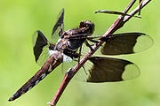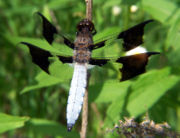
Pruinescence
Encyclopedia
 |
Pruinescence, or pruinosity, is a "bloom" caused by pigment on top of an insect's cuticle
Cuticle
A cuticle , or cuticula, is a term used for any of a variety of tough but flexible, non-mineral outer coverings of an organism, or parts of an organism, that provide protection. Various types of "cuticles" are non-homologous; differing in their origin, structure, function, and chemical composition...
that covers up the underlying coloration, giving a dusty or frosted appearance. The pruinescence is commonly white to pale blue in color, but can also be gray, pink, purple, or red; these colors may be produced by Tyndall scattering
Tyndall effect
The Tyndall effect, also known as Tyndall scattering, is light scattering by particles in a colloid or particles in a fine suspension. It is named after the 19th century physicist John Tyndall. It is similar to Rayleigh scattering, in that the intensity of the scattered light depends on the fourth...
of light. When pale in color, pruinescence often strongly reflects ultraviolet
Ultraviolet
Ultraviolet light is electromagnetic radiation with a wavelength shorter than that of visible light, but longer than X-rays, in the range 10 nm to 400 nm, and energies from 3 eV to 124 eV...
.
The adjectival form is pruinose.
Pruinescence is found in many species of Odonata
Odonata
Odonata is an order of insects, encompassing dragonflies and damselflies . The word dragonfly is also sometimes used to refer to all Odonata, but the back-formation odonate is a more correct English name for the group as a whole...
, particularly damselflies of the families Lestidae
Lestidae
Lestidae is a rather small family of cosmopolitan, large-sized, slender damselflies. They are of the order of the dragonflies and are commonly known as "Spreadwings." There are two subfamilies in Lestdae. The first subfamily is Lestinae. Damselflies in Lestinae rest with their wings partly open...
and Coenagrionidae
Coenagrionidae
The insect family Coenagrionidae is found in the order Odonata and the suborder Zygoptera. The Zygoptera are the damselflies, which although less known than the dragonflies, are no less common. There are more than 1100 species in this family, making it the largest damselfly family...
, where it occurs on the wings and body. Among true dragonflies it is most common on male Libellulidae
Libellulidae
The skimmers or perchers and their relatives form the Libellulidae, the largest dragonfly family in the world. It is sometimes considered to contain the Corduliidae as the subfamily Corduliinae and the Macromiidae as the subfamily Macromiinae. Even if these are excluded , there still remains a...
(skimmers).
In the Common Whitetail
Common Whitetail
The Common Whitetail or Long-tailed Skimmer is a common dragonfly across much of North America, with a striking and unusual appearance. The male's chunky white body , combined with the brownish-black bands on its otherwise translucent wings, give it a checkered look...
and Blue Dasher
Blue Dasher
The Blue Dasher is a dragonfly of the skimmer family. It is common and widely distributed in the United States....
dragonflies (Plathemis lydia and Pachydiplax longipennis), males display the pruinescence on the back of the abdomen to other males as a territorial threat. Other Odonata may use pruinescence to recognize members of their own species or to cool their bodies by reflecting radiation away.
Use for plants
The term pruinosity is also applied for "blooms" on plants, for example on the skin of grapeGrape
A grape is a non-climacteric fruit, specifically a berry, that grows on the perennial and deciduous woody vines of the genus Vitis. Grapes can be eaten raw or they can be used for making jam, juice, jelly, vinegar, wine, grape seed extracts, raisins, molasses and grape seed oil. Grapes are also...
s.

